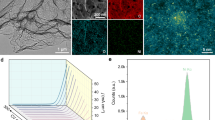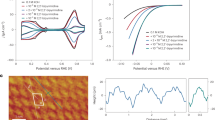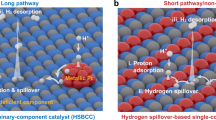Abstract
The linear scaling relationships between the adsorption energies of multiple intermediates constrain the maximum reaction activity of heterogeneous catalysis. Here we propose an intermediate spillover strategy to decouple the elementary electron-transfer steps in an electrochemical reaction by building a bi-component interface, thereby independently tuning the corresponding intermediate adsorption at an individual catalytic surface. Taking the electrocatalytic oxygen reduction reaction as an example, oxophilic sites are preferable for activating oxygen molecules, then the adsorbed OH* intermediates spontaneously migrate to the adjacent sites with a weaker oxygen binding energy, where OH* intermediates are further reduced and desorbed to complete the overall catalytic cycle. Consequently, the designed Pd/Ni(OH)2 catalyst can remarkably elevate the half-wave potential of the oxygen reduction reaction to ~70 mV higher than that of the Pt/C catalyst, surmounting the theoretical overpotential limit of Pd. This design principle highlights an opportunity for utilizing intermediate spillover to break the ubiquitous scaling relationships in multi-step catalytic reactions.

This is a preview of subscription content, access via your institution
Access options
Access Nature and 54 other Nature Portfolio journals
Get Nature+, our best-value online-access subscription
27,99 € / 30 days
cancel any time
Subscribe to this journal
Receive 12 digital issues and online access to articles
118,99 € per year
only 9,92 € per issue
Buy this article
- Purchase on SpringerLink
- Instant access to full article PDF
Prices may be subject to local taxes which are calculated during checkout




Similar content being viewed by others
Data availability
The data that support the findings of this study are available from the corresponding authors upon reasonable request. Source data are provided with this paper.
References
Chu, S. & Majumdar, A. Opportunities and challenges for a sustainable energy future. Nature 488, 294–303 (2012).
Sabatier, P. La Catalyse en Chimie Organique (Librarie Polytechnique, 1913).
Seh, Z. W. et al. Combining theory and experiment in electrocatalysis: insights into materials design. Science 355, eaad4998 (2017).
Nørskov, J. K., Bligaard, T., Rossmeisl, J. & Christensen, C. H. Towards the computational design of solid catalysts. Nat. Chem. 1, 37–46 (2009).
Nørskov, J. K., Abild-Pedersen, F., Studt, F. & Bligaard, T. Density functional theory in surface chemistry and catalysis. Proc. Natl Acad. Sci. USA 108, 937–943 (2011).
Bligaard, T. et al. The Brønsted–Evans–Polanyi relation and the volcano curve in heterogeneous catalysis. J. Catal. 224, 206–217 (2004).
Abild-Pedersen, F. et al. Scaling properties of adsorption energies for hydrogen-containing molecules on transition-metal surfaces. Phys. Rev. Lett. 99, 016105 (2007).
Zhao, Z.-J. et al. Theory-guided design of catalytic materials using scaling relationships and reactivity descriptors. Nat. Rev. Mater. 4, 792–804 (2019).
Montoya, J. H. et al. Materials for solar fuels and chemicals. Nat. Mater. 16, 70–81 (2017).
Wang, Q., Cheng, Y., Yang, H. B., Su, C. & Liu, B. Integrative catalytic pairs for efficient multi-intermediate catalysis. Nat. Nanotechnol. 19, 1442–1451 (2024).
Wang, P. et al. Breaking scaling relations to achieve low-temperature ammonia synthesis through LiH-mediated nitrogen transfer and hydrogenation. Nat. Chem. 9, 64–70 (2017).
Kibsgaard, J. & Chorkendorff, I. Considerations for the scaling-up of water splitting catalysts. Nat. Energy 4, 430–433 (2019).
Wang, X. et al. Pivotal role of reversible NiO6 geometric conversion in oxygen evolution. Nature 611, 702–708 (2022).
Vojvodic, A. & Nørskov, J. K. New design paradigm for heterogeneous catalysts. Natl Sci. Rev. 2, 140–143 (2015).
Khorshidi, A., Violet, J., Hashemi, J. & Peterson, A. A. How strain can break the scaling relations of catalysis. Nat. Catal. 1, 263–268 (2018).
Pérez-Ramírez, J. & López, N. Strategies to break linear scaling relationships. Nat. Catal. 2, 971–976 (2019).
Xiong, L. et al. Breaking the linear scaling relationship by compositional and structural crafting of ternary Cu–Au/Ag nanoframes for electrocatalytic ethylene production. Angew. Chem. Int. Ed. 60, 2508–2518 (2021).
Gao, Q. et al. Breaking adsorption-energy scaling limitations of electrocatalytic nitrate reduction on intermetallic CuPd nanocubes by machine-learned insights. Nat. Commun. 13, 2338 (2022).
Zhang, B. et al. Homogeneously dispersed multimetal oxygen-evolving catalysts. Science 352, 333–337 (2016).
Wang, Q. et al. Atomic metal–non-metal catalytic pair drives efficient hydrogen oxidation catalysis in fuel cells. Nat. Catal. 6, 916–926 (2023).
Xiong, M., Gao, Z. & Qin, Y. Spillover in heterogeneous catalysis: new insights and opportunities. ACS Catal. 11, 3159–3172 (2021).
Jiang, L. et al. Facet engineering accelerates spillover hydrogenation on highly diluted metal nanocatalysts. Nat. Nanotechnol. 15, 848–853 (2020).
Dai, J. et al. Hydrogen spillover in complex oxide multifunctional sites improves acidic hydrogen evolution electrocatalysis. Nat. Commun. 13, 1189 (2022).
Shen, X. et al. Dual-site cascade oxygen reduction mechanism on SnOx/Pt-Cu-Ni for promoting reaction kinetics. J. Am. Chem. Soc. 141, 9463–9467 (2019).
Liu, Y. et al. Direct observation of accelerating hydrogen spillover via surface-lattice-confinement effect. Nat. Commun. 14, 613 (2023).
Koper, M. T. M. Thermodynamic theory of multi-electron transfer reactions: implications for electrocatalysis. J. Electroanal. Chem. 660, 254–260 (2011).
Yang, C.-L. et al. Sulfur-anchoring synthesis of platinum intermetallic nanoparticle catalysts for fuel cells. Science 374, 459–464 (2021).
Gao, R. et al. Pt/Fe2O3 with Pt–Fe pair sites as a catalyst for oxygen reduction with ultralow Pt loading. Nat. Energy 6, 614–623 (2021).
Lopes, P. P. et al. Eliminating dissolution of platinum-based electrocatalysts at the atomic scale. Nat. Mater. 19, 1207–1214 (2020).
Debe, M. K. Electrocatalyst approaches and challenges for automotive fuel cells. Nature 486, 43–51 (2012).
Christensen, R., Hansen, H. A., Dickens, C. F., Nørskov, J. K. & Vegge, T. Functional independent scaling relation for ORR/OER catalysts. J. Phys. Chem. C 120, 24910–24916 (2016).
Zhang, J., Yang, H. B., Zhou, D. & Liu, B. Adsorption energy in oxygen electrocatalysis. Chem. Rev. 122, 17028–17072 (2022).
Markovic, N., Gasteiger, H. & Ross, P. N. Kinetics of oxygen reduction on Pt(hkl) electrodes: implications for the crystallite size effect with supported Pt electrocatalysts. J. Electrochem. Soc. 144, 1591 (1997).
Antolini, E. Palladium in fuel cell catalysis. Energy Environ. Sci. 2, 915–931 (2009).
Yang, Y. et al. Combinatorial studies of palladium-based oxygen reduction electrocatalysts for alkaline fuel cells. J. Am. Chem. Soc. 142, 3980–3988 (2020).
Zhang, J. et al. In situ precise tuning of bimetallic electronic effect for boosting oxygen reduction catalysis. Nano Lett. 21, 7753–7760 (2021).
Mori, K. et al. Phenylamine-functionalized mesoporous silica supported PdAg nanoparticles: a dual heterogeneous catalyst for formic acid/CO2-mediated chemical hydrogen delivery/storage. Chem. Commun. 53, 4677–4680 (2017).
Mori, K., Sano, T., Kobayashi, H. & Yamashita, H. Surface engineering of a supported PdAg catalyst for hydrogenation of CO2 to formic acid: elucidating the active Pd atoms in alloy nanoparticles. J. Am. Chem. Soc. 140, 8902–8909 (2018).
Zamora Zeledón, J. A. et al. Tuning the electronic structure of Ag–Pd alloys to enhance performance for alkaline oxygen reduction. Nat. Commun. 12, 620 (2021).
Wang, X. P. et al. Strain stabilized nickel hydroxide nanoribbons for efficient water splitting. Energy Environ. Sci. 13, 229–237 (2020).
Wang, Q. et al. Long-term stability challenges and opportunities in acidic oxygen evolution electrocatalysis. Angew. Chem. Int. Ed. 62, e202216645 (2023).
Dong, J.-C. et al. In situ Raman spectroscopic evidence for oxygen reduction reaction intermediates at platinum single-crystal surfaces. Nat. Energy 4, 60–67 (2019).
Zhang, X.-L. et al. Strongly coupled cobalt diselenide monolayers for selective electrocatalytic oxygen reduction to H2O2 under acidic conditions. Angew. Chem. Int. Ed. 60, 26922–26931 (2021).
Yang, J. et al. Dynamic behavior of single-atom catalysts in electrocatalysis: identification of Cu-N3 as an active site for the oxygen reduction reaction. J. Am. Chem. Soc. 143, 14530–14539 (2021).
Tromp, M. et al. High energy resolution fluorescence detection X-ray absorption spectroscopy: detection of adsorption sites in supported metal catalysts. AIP Conf. Proc. 882, 651–653 (2007).
Wang, J., Zhou, J., Hu, Y. & Regier, T. Chemical interaction and imaging of single Co3O4/graphene sheets studied by scanning transmission X-ray microscopy and X-ray absorption spectroscopy. Energy Environ. Sci. 6, 926–934 (2013).
Gaur, A. & Shrivastava, B. D. Speciation using X-ray absorption fine structure (XAFS). Rev. J. Chem. 5, 361–398 (2015).
Wang, Q. et al. Coordination engineering of iridium nanocluster bifunctional electrocatalyst for highly efficient and pH-universal overall water splitting. Nat. Commun. 11, 4246 (2020).
Wang, J. et al. Exceptionally active and stable RuO2 with interstitial carbon for water oxidation in acid. Chem 8, 1673–1687 (2022).
Wu, T. et al. Iron-facilitated dynamic active-site generation on spinel CoAl2O4 with self-termination of surface reconstruction for water oxidation. Nat. Catal. 2, 763–772 (2019).
Peng, L. et al. Atomic cation-vacancy engineering of NiFe-layered double hydroxides for improved activity and stability towards the oxygen evolution reaction. Angew. Chem. Int. Ed. 60, 24612–24619 (2021).
Zhu, Y. et al. Oxygen activation on Ba-containing perovskite materials. Sci. Adv. 8, eabn4072 (2022).
Zhang, J. et al. Advances in thermodynamic-kinetic model for analyzing the oxygen evolution reaction. ACS Catal. 10, 8597–8610 (2020).
Wang, J. et al. Redirecting dynamic surface restructuring of a layered transition metal oxide catalyst for superior water oxidation. Nat. Catal. 4, 212–222 (2021).
Jin, Z. et al. Understanding the inter-site distance effect in single-atom catalysts for oxygen electroreduction. Nat. Catal. 4, 615–622 (2021).
Luo, M. et al. PdMo bimetallene for oxygen reduction catalysis. Nature 574, 81–85 (2019).
Liang, J. et al. Gas-balancing adsorption strategy towards noble-metal-based nanowire electrocatalysts. Nat. Catal. 7, 719–732 (2024).
Liu, C. et al. Oxygen evolution reaction over catalytic single-site Co in a well-defined brookite TiO2 nanorod surface. Nat. Catal. 4, 36–45 (2021).
Liu, S. et al. A top-down strategy for amorphization of hydroxyl compounds for electrocatalytic oxygen evolution. Nat. Commun. 13, 1187 (2022).
Zhang, B. et al. High-valence metals improve oxygen evolution reaction performance by modulating 3d metal oxidation cycle energetics. Nat. Catal. 3, 985–992 (2020).
Kresse, G. & Furthmüller, J. Efficient iterative schemes for ab initio total-energy calculations using a plane-wave basis set. Phys. Rev. B 54, 11169–11186 (1996).
Kresse, G. & Furthmüller, J. Efficiency of ab-initio total energy calculations for metals and semiconductors using a plane-wave basis set. Comput. Mater. Sci. 6, 15–50 (1996).
Kresse, G. & Joubert, D. From ultrasoft pseudopotentials to the projector augmented-wave method. Phys. Rev. B 59, 1758–1775 (1999).
Henkelman, G., Uberuaga, B. P. & Jónsson, H. A climbing image nudged elastic band method for finding saddle points and minimum energy paths. J. Chem. Phys. 113, 9901–9904 (2000).
Nosé, S. A unified formulation of the constant temperature molecular dynamics methods. J. Chem. Phys. 81, 511–519 (1984).
Hoover, W. G. Canonical dynamics: equilibrium phase-space distributions. Phys. Rev. A 31, 1695–1697 (1985).
VandeVondele, J. & Hutter, J. Gaussian basis sets for accurate calculations on molecular systems in gas and condensed phases. J. Chem. Phys. 127, 114105 (2007).
Woo, T. K., Margl, P. M., Blöchl, P. E. & Ziegler, T. A combined Car-Parrinello QM/MM implementation for ab initio molecular dynamics simulations of extended systems: application to transition metal catalysis. J. Phys. Chem. B 101, 7877–7880 (1997).
Sprik, M. & Ciccotti, G. Free energy from constrained molecular dynamics. J. Chem. Phys. 109, 7737–7744 (1998).
Cramer, C. J. Essentials of Computational Chemistry: Theories and Models 2nd edn (Wiley, 2004).
Nørskov, J. K. et al. Origin of the overpotential for oxygen reduction at a fuel-cell cathode. J. Phys. Chem. B 108, 17886–17892 (2004).
Jones, R. O. & Gunnarsson, O. The density functional formalism, its applications and prospects. Rev. Mod. Phys. 61, 689–746 (1989).
Greeley, J. et al. Alloys of platinum and early transition metals as oxygen reduction electrocatalysts. Nat. Chem. 1, 552–556 (2009).
Viswanathan, V., Hansen, H. A., Rossmeisl, J. & Nørskov, J. K. Universality in oxygen reduction electrocatalysis on metal surfaces. ACS Catal. 2, 1654–1660 (2012).
Acknowledgements
This work was supported financially by the City University of Hong Kong startup fund (9020003), an ITF-RTH–Global STEM Professorship (9446006), and the JC STEM lab of Advanced CO2 Upcycling (9228005). S.-F.H. acknowledges financial support from the National Science and Technology Council, Taiwan (contract no. NSTC 111-2628-M-A49-008) and Yushan Young Scholar Program and the Center for Emergent Functional Matter Science, Ministry of Education, Taiwan. H.B.T. acknowledges financial support from the National Key R&D Program of China (2023YFB4004600). H.B.Y. acknowledges support from the National Natural Science Foundation of China under grant no. 22075195. W.L. is grateful for support from the National Natural Science Foundation of China (22427801). Y.X. acknowledges financial support from the National Natural Science Foundation of China (22478348). C.S. is financially supported by the National Key Research and Development Program of China (2021YFA1600800). J.G.C. is sponsored by the US Department of Energy (contract no. DE-SC0012704).
Author information
Authors and Affiliations
Contributions
Q.W., H.B.T. and B.L. conceived and designed the project. Q.W., K.L., H.B.T., L.Z., J.Z., Y.C., J.C. and Y.X. performed the catalyst synthesis, structural characterizations and electrochemical measurements. S.-F.H., H.B.Y., N.H. and Y.L. acquired the X-ray absorption spectroscopies and provided expertise for data analysis. W.L. and W.W. obtained the TEM images. X.H. and F.L. carried out the theoretical calculations. Q.W., H.B.T., C.S., J.G.C. and B.L. discussed the results and drafted the paper. All authors reviewed and contributed to this paper.
Corresponding authors
Ethics declarations
Competing interests
The authors declare no competing interests.
Peer review
Peer review information
Nature Catalysis thanks the anonymous reviewers for their contribution to the peer review of this work.
Additional information
Publisher’s note Springer Nature remains neutral with regard to jurisdictional claims in published maps and institutional affiliations.
Supplementary information
Supplementary Information
Table of Contents; Supplementary Figs. 1–31, Tables 1–3 and References.
Supplementary Video 1
AIMD simulations for the spillover of adsorbed OH* from Pd sites to the nearby Ag surface.
Supplementary Data 1
Atomic coordinates of the optimized computational models, initial and final configurations in AIMD simulations.
Source data
Source Data Fig. 1
Source data Fig. 1
Source Data Fig. 2
Source data Fig. 2
Source Data Fig. 3
Source data Fig. 3
Source Data Fig. 4
Source data Fig. 4
Rights and permissions
Springer Nature or its licensor (e.g. a society or other partner) holds exclusive rights to this article under a publishing agreement with the author(s) or other rightsholder(s); author self-archiving of the accepted manuscript version of this article is solely governed by the terms of such publishing agreement and applicable law.
About this article
Cite this article
Wang, Q., Hung, SF., Lao, K. et al. Breaking the linear scaling limit in multi-electron-transfer electrocatalysis through intermediate spillover. Nat Catal 8, 378–388 (2025). https://doi.org/10.1038/s41929-025-01323-8
Received:
Accepted:
Published:
Issue Date:
DOI: https://doi.org/10.1038/s41929-025-01323-8



